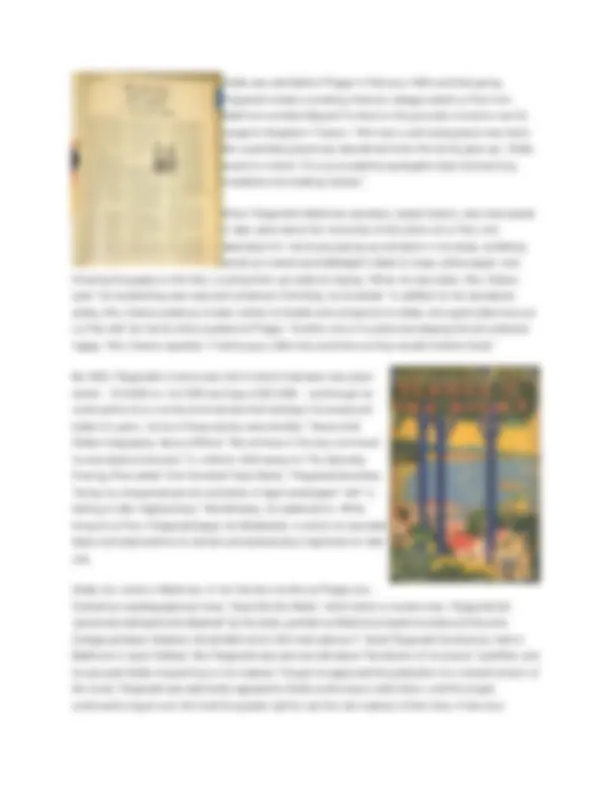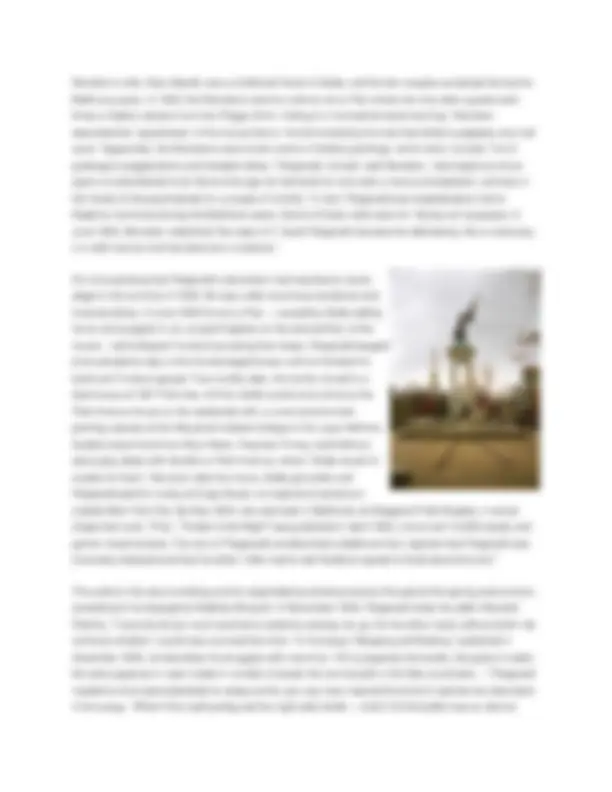






Study with the several resources on Docsity

Earn points by helping other students or get them with a premium plan


Prepare for your exams
Study with the several resources on Docsity

Earn points to download
Earn points by helping other students or get them with a premium plan
Community
Ask the community for help and clear up your study doubts
Discover the best universities in your country according to Docsity users
Free resources
Download our free guides on studying techniques, anxiety management strategies, and thesis advice from Docsity tutors
F. Scott Fitzgerald's time in Baltimore, a period marked by personal and professional challenges. Despite Zelda's hospitalizations and Fitzgerald's financial struggles, Baltimore provided the family with a sense of stability that helped Fitzgerald complete 'Tender is the Night'. The document also delves into Fitzgerald's literary connections to Baltimore, including his first editor, H.L. Mencken, and his friendship with Marxist critic V.F. Calverton.
Typology: Lecture notes
1 / 8

This page cannot be seen from the preview
Don't miss anything!





In the dark, a man paces. He gazes out over the city, but a gray mist obscures all landmarks. Suddenly, a specter appears. “Like a broken- stringed bow upon a throbbing fiddle— I see the real horror develop over the roof-tops, and in the strident horns of night-owl taxis and the shrill monody of revelers’ arrival over the way. Horror and waste. Waste and horror— what I might have been and done that is lost, spent and gone, dissipated, unrecapturable.”
Asked which writer penned these despairing words in Baltimore, most would probably guess Edgar Allan Poe. But the ghostly echoes of pleasure-seeking gone sour point to the true author: F. Scott Fitzgerald. The laureate of the Jazz Age was only 36 when he came to Baltimore in
Even so, Baltimore gave the peripatetic Fitzgerald family something they’d never really had before: a home. The nearly five years that Scott, Zelda and their daughter, Scottie, lived in Baltimore was the biggest chunk of time the family ever spent together in one location, says University of Maryland professor emeritus Jackson Bryer. “Five years in one place is a pretty long time for them,” he points out. Though Zelda was a patient at the Henry Phipps Clinic at Johns Hopkins and the Sheppard-Pratt Hospital for much of that time (with a short stint at Craig House outside New York City in between), “they had a stable life here,” says Bryer. “And the relative stability of Baltimore and having his family all in one place may have given Fitzgerald what he needed to finish ‘Tender is the Night.’”
Fitzgerald’s Maryland roots go deeper than those of most writers who have spent time in Baltimore. Though born and (mostly) raised in St. Paul, Minn., Fitzgerald was descended on his father’s side from a number of pre-Revolutionary Maryland families— Francis Scott Key was his second cousin, twice-removed. The Sage of Baltimore, H.L. Mencken, was Fitzgerald’s first editor, publishing his story, “Babes in the Woods,” in 1919. Soon afterward, Fitzgerald met Zelda Sayre, the Alabama teenager who would, for better or worse, change his life. For 10 years following their 1920 marriage, Scott and Zelda were A-list celebrities, behaving much like today’s young stars who are blessed with fame and money but lack the maturity to handle either.
Both Scott and Zelda were genetically primed for terrible diseases— in his case, alcoholism, and in her case, schizophrenia. Their riotous Roaring ’20s lifestyle— constant drinking, drama and departures— catalyzed those illnesses. “Nothing could have survived our life,” Fitzgerald once wrote to Zelda.
By 1930, Scott was an alcoholic and Zelda had suffered the first of her multiple breakdowns, fighting her way back to sanity over 15 months in a Swiss clinic. After Zelda’s release in September 1931, the couple and Scottie, then 10, returned to the United States, but five months later, Zelda fell apart again. When Fitzgerald wrote to Mencken for advice, the latter suggested the Phipps Clinic at Johns Hopkins, at that time the nation’s premier institution for the treatment of the mentally ill. Phipps director Adolf Meyer advocated a scientific approach to psychiatry but believed that psychogenetic factors, not physical disease, caused most mental illness. He thought that people became mentally ill “by actually living in ways that put their mind and entire organism and its activity in jeopardy.” The Fitzgeralds— whose marriage Meyer diagnosed as a “folie a deux”— seemed a living embodiment of his theories, which perhaps explains why they both detested him.
session at La Paix with Phipps psychiatrist Thomas Rennie, in which the couple aired their grievances, was “the Armageddon of marital fights,” Bell said, and ended with both of them threatening to “go to law” (end the marriage). Soon afterward, Zelda switched to drama, writing a play called “Scandalabra,” which was produced by Baltimore’s Vagabond Junior Players in the summer of 1933.
Though most biographical accounts of Fitzgerald’s life treat the Baltimore years as unremittingly bleak, literary scholar Joan Hellman, an organizer of the conference who has long researched the author’s life in Baltimore, says that the Fitzgeralds “had a normal family life here for a while, until Zelda’s second breakdown.” Hellman, now retired from the Community College of Baltimore County, first became interested in Fitzgerald as a graduate student. “I never stopped reading about him and when I came to Baltimore in 1977, it hit me that La Paix was here,” she says. She went looking for the house, only to learn it had been torn down in 1961. As the centennial of Fitzgerald’s birth approached in 1996, Hellman sought out people who had known Fitzgerald during his Baltimore years, interviewing them and collecting photos. “People on the whole had funny stories to tell,” she says. “Everybody had a drinking story, which is sad.”
While the family was living at La Paix, from May 1932 to November 1933, they “went to parties and movies,” Hellman says, and were listed in the Baltimore Blue Book as “at home for visitors.” Related to the Ridgely family, Fitzgerald was invited to dine at Hampton Mansion in Baltimore County. Eleanor Turnbull, 9 years old when the Fitzgeralds arrived at La Paix, “and very taken with Fitzgerald,” says Hellman, recalled him taking Scottie and her and her siblings to the movies in Towson Town, a short walk down the lane, and swimming at Meadowbrook. Fitzgerald car-pooled with the Turnbulls— Scottie attended first the Calvert School and then Bryn Mawr— and later wrote a story for The Saturday Evening Post called “The Family Bus” about the experience. “He wrote little plays for the children to perform and he’d put the kids in the car and go around the countryside,” says Hellman. Not that Fitzgerald was terribly skilled behind the wheel. In a 1960 interview, his chauffeur, Towson resident Aquilla Keating, told a Baltimore Sun reporter, “I remember that Mr. Fitzgerald was one real bad driver.” In his diary, H.L. Mencken describes Fitzgerald’s driving as “fearful and wonderful.”
In another diary entry from April 1932, Mencken describes the Fitzgeralds as they appeared shortly after their arrival in Baltimore. “F. Scott Fitzgerald and his wife were here to lunch yesterday. Mrs. Fitzgerald is a patient at the Phipps Clinic. The poor girl went insane in Paris a year or so ago, and is still plainly more or less off her base. She managed to get through lunch quietly enough, but there was a wild look in her eye, and now and then she showed plain signs of her mental distress.” Fitzgerald, he added, “is a charming fellow, and when sober makes an excellent companion. Unfortunately, liquor sets him wild and he is apt, when drunk, to knock over a dinner table, or run his automobile into a bank building.”
Mencken’s wife, Sara Haardt, was a childhood friend of Zelda, and the two couples socialized during the Baltimore years. In 1933, the Menckens went to a dinner at La Paix where the only other guests were three of Zelda’s doctors from the Phipps Clinic. Calling it a “somewhat weird evening,” Mencken described the “spookiness” of the house that is “not diminished by the fact that Zelda is palpably only half sane.” Apparently, the Menckens were shown some of Zelda’s paintings, which were, he said, “full of grotesque exaggerations and fantastic ideas.” Fitzgerald, himself, said Mencken, “also begins to show signs of a disordered mind. Some time ago he had what he now calls a nervous breakdown, and was in the hands of the psychiatrists for a couple of months.” In fact, Fitzgerald was hospitalized at Johns Hopkins nine times during the Baltimore years. Some of those visits were for “drying out” purposes. In June 1934, Mencken noted that “the case of F. Scott Fitzgerald has become distressing. He is a boozing in a wild manner and has become a nuisance.”
It’s not surprising that Fitzgerald’s alcoholism had reached an acute stage in the summer of 1934. He was under enormous emotional and financial stress. A June 1933 fire at La Paix— caused by Zelda setting fire to some papers in an unused fireplace on the second floor of the house— led to Bayard Turnbull canceling their lease. Fitzgerald begged to be allowed to stay in the fire-damaged house until he finished his book and Turnbull agreed. Two months later, the family moved to a townhouse at 1307 Park Ave. At first, Zelda could come home to the Park Avenue house on the weekends with a nurse and she took painting classes at the Maryland Institute College of Art, says Hellman. Scottie’s best friend from Bryn Mawr, Peaches Finney, told Hellman about play dates with Scottie on Park Avenue, where “Zelda would fix snacks for them.” But soon after the move, Zelda got sicker and Fitzgerald paid for a stay at Craig House, an expensive sanitarium outside New York City. By May 1924, she was back in Baltimore at Sheppard Pratt Hospital, in worse shape than ever. Then, “Tender Is the Night” was published in April 1934, only to sell 13,000 copies and garner mixed reviews. The son of Fitzgerald’s landlord told a Baltimore Sun reporter that Fitzgerald was financially stressed and that his father “often had to ask Scottie to speak to Scott about the rent.”
The author’s life was crumbling and he responded by drinking heavily throughout the spring and summer, according to his biographer Matthew Bruccoli. In November 1934, Fitzgerald wrote his editor Maxwell Perkins, “I have drunk too much and that is certainly slowing me up. On the other hand, without drink I do not know whether I could have survived this time.” In his essay “Sleeping and Waking,” published in December 1934, he describes his struggles with insomnia. “All is prepared, the books, the glass of water, the extra pajamas in case I wake in rivulets of sweat, the luminal pills in the little round tube…” Fitzgerald needed luminal (phenobarbital) to sleep and its use may have inspired the kind of night terrors described in the essay. “What if this night prefigured the night after death— what if all thereafter was an eternal
“Scandalabra.” He kept in touch with Princeton classmates living in the city like Edgar Allan Poe Jr. He wrote an introduction to “Historic and Colonial Homes of Maryland” for his friends Don and Rita Swann, whose son, Francis, he met at the Vagabond Players. Early in his Baltimore residence, he even attended a frat party at Hopkins, according to former Baltimore Sun reporter Carl Schoettler. And at one party in Homeland given by a host with the surname of Diver, Hellman says, Fitzgerald may have picked up the name of his tragic hero in “Tender is the Night.” A parade of famous friends also visited the Fitzgeralds in Baltimore, including John Dos Passos, Gertrude Stein, Thomas Wolfe, Edmund Wilson and Malcolm Cowley.
In April 1936, Fitzgerald transferred Zelda to Highland Hospital in Asheville, N.C., and once again behind in his rent, he gave up the Cambridge Arms apartment that summer. Scottie, who was still at Bryn Mawr, lived alternately with the family of her friend Peaches and Mrs. Owens. In August Fitzgerald published a slightly happier story in Esquire, “Afternoon of an Author,” describing a bus ride from his Cambridge Arms apartment to the barbershop. “When he woke up he felt better than he had for many weeks, a fact that became plain to him negatively— he did not feel ill,” the nameless narrator of the story notes. Still, he takes the precaution of including “a small phial of luminal” in his pocket for the ride. “The perfect neurotic,” the narrator mutters while contemplating his image in a mirror.
In December, while staying at the Stafford Hotel in Mount Vernon, Fitzgerald got blazing drunk at a formal party at The Belvedere he was hosting for Scottie and her friends. That debacle led to a binge, which led to another drying out at Hopkins. He left the city shortly afterward, never to return, though Scottie long considered Baltimore her hometown and married a Baltimore man, Jack Lanahan, after her graduation from Vassar. “We used to come here for all the holidays,” Scottie’s daughter, Cecilia Ross, said at the Fitzgerald conference in October 2009. “My sister did the whole Cotillion thing here.” Cecilia attended the Oldfields School and her sister, Eleanor, graduated from St. Timothy’s.
On Dec. 21, 1940, Fitzgerald died of a heart attack in Hollywood at the age of 44. Zelda held on for a few more years, dying in a fire at Highland Hospital in March 1948. An enduring myth suggests that Zelda set the fire; she did not. It started in the kitchen while Zelda slept in her room on the top floor. Nine women unable to escape their locked rooms died in the fire. The details of treatments for schizophrenia that Zelda endured at clinics in Europe and the U.S. in that pre-pharmacological age are horrible to contemplate. “Don’t ever fall into the hands of brain and nerve specialists unless you are feeling very Faustian,” Zelda once wrote to a friend.
Like many alcoholics, Fitzgerald was often consumed by self-loathing and regret, much of it well-earned. Yet, till the end of his life he worked hard to finance Zelda’s very expensive psychiatric care and to provide Scottie with an excellent education. Zelda often thanked him for his enduring loyalty and devotion, as in a letter dated July 1939— “Nobody is better aware than I am, and I believe, so is Scottie, of your generosity, and the seriousness of your constant struggle to provide the best for us. I am most deeply grateful to you for the sustained and tragic effort that you have made to keep us going.”
The Fitzgeralds— Scott, Zelda and Scottie— are buried at St. Mary’s Church in Rockville, close by Scott’s parents and other Maryland relations. Before her own death in 1986, Scottie fought to have her parents re-interred at St. Mary’s; initially they were buried at Union Cemetery in Rockville when the Catholic Church refused permission for Fitzgerald to be buried at St. Mary’s because he was not a practicing Catholic at the time of his death. Scottie felt that her father would have wanted to be buried with his ancestors, though Fitzgerald once expressed a different wish in a letter on Stafford Hotel stationery he wrote to his North Carolina secretary in 1936.
“I love Baltimore more than I thought— it is so rich with memories— it is nice to look up the street and see the statue of my great uncle & to know that Poe is buried here and that many ancestors have walked in the old town by the bay. I belong here, where everything is civilized and gay and rotted and polite. And I wouldn’t mind a bit if in a few years Zelda & I could snuggle up together under a stone in some old graveyard here. That is really a happy thought and not melancholy at all.”